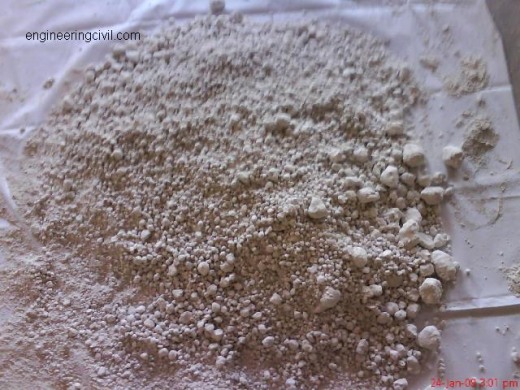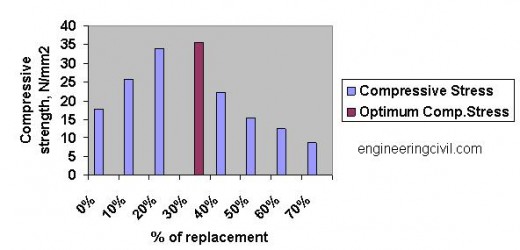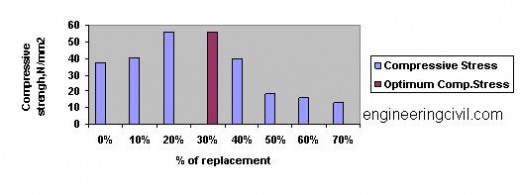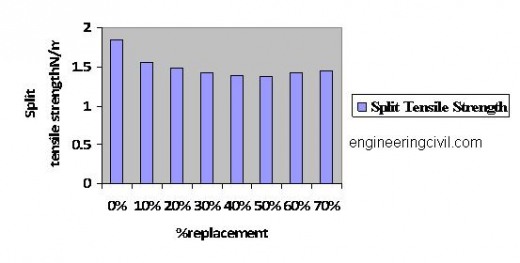ABSTRACT
Over 300 million tones of industrial wastes are being produced per annum by chemical and agricultural process in India. These materials pose problems of disposal and health hazards. The wastes like phosphogypsum, fluorogypsum and red mud contain obnoxious impurities which adversely affect the strength and other properties of building materials based on them. Out of several wastes being produced at present, the use of phosphogypsum, flurogypsum, lime sludge, hypo sludge, red mud, and mine tailing is of paramount significance to protect the environment.
Paper making generally produces a large amount of solid waste. Paper fibers can be recycled only a limited number of times before they become too short or weak to make high quality paper. It means that the broken, low- quality paper fibers are separated out to become waste sludge. All the inks, dyes, coatings, pigments, staples and “stickies” (tape, plastic films, etc.) are also washed off the recycled fibers to join the waste solids. The shiny finish on glossy magazine-type paper is produced using a fine kaolin clay coating, which also becomes solid waste during recycling. This paper mill sludge consumes a large percentage of local landfill space for each and every year. Worse yet, some of the wastes are land spread on cropland as a disposal technique, raising concerns about trace contaminants building up in soil or running off into area lakes and streams. Some companies burn their sludge in incinerators, contributing to our serious air pollution problems. To reduce disposal and pollution problems emanating from these industrial wastes, it is most essential to develop profitable building materials from them. Keeping this in view, investigations were undertaken to produce low cast concrete by blending various ratios of cement with hypo sludge.
This project is concerned with experimental investigation on strength of concrete and optimum percentage of the partial replacement by replacing cement via 10%, 20%, 30%, 40%, 50%, 60% and 70% of Hypo Sludge.
Keywords: Hypo Sludge, Pozzolanic Property, supplementary cementitious materials.
INTRODUCTION
General Energy plays a crucial role in growth of developing countries like India. In the context of low availability of non-renewable energy resources coupled with the requirements of large quantities of energy for Building materials like cement, the importance of using industrial waste cannot be under estimated.
During manufacturing of 1 tones of Ordinary Portland Cement we need about 1-1? tonnes of earth resources like limestone, etc. Further during manufacturing of 1 tonnes of Ordinary Portland Cement an equal amount of carbon-di-oxide are released into the atmosphere. The carbon-di-oxide emissions act as a silent Killer in the environment as various forms. In this Backdrop, the search for cheaper substitute to OPC is a needful one.
SOLID WASTE FROM PAPER INDUSTRY
Hypo Sludge Properties
Where, this hypo sludge contains, low calcium and maximum calcium chloride and minimum amount of silica. Hypo sludge behaves like cement because of silica and magnesium properties. This silica and magnesium improve the setting of the concrete.
Fig 1- Raw Hypo sludge disposal from TNPL
Need For Hypo Sludge Utilization
While producing paper the various wastes are comes out from the various processes in paper industries. From the preliminary waste named as hypo sludge due to its low calcium is taken out for our project to replace the cement utilization in concrete. Due to the cement production green house gases are emitted in the atmosphere. For producing 4million tones of cement, they emit 1 million ton green house gases are emitted. Also, to reduce the environmental degradation, this sludge has been avoided in mass level disposal in land. To eliminate the ozone layer depletion, production of cement becomes reduced. For this, the hypo sludge is used as partial replacement in the concrete as high performance concrete. By utilizing this waste the strength will be increased and also cost reduction in the concrete is achieved.
OBJECTIVES
To investigate the utilization of Hypo Sludge as Supplementary Cementitious Materials (SCM) and influence of these hypo sludge on the Strength on concretes made with different Cement replacement levels
MATERIALS USED
Cement
The most common cement is used is ordinary Portland cement. The Type 1 is preferred according to IS: 269-1976, which is used for general concrete structures. Out of the total production, ordinary Portland cement accounts for about 80-90 percent. Many tests were conducted to cement some of them are consistency tests, setting tests, soundness tests, etc.
Aggregate
Aggregates are the important constituents in concrete. They give body to the concrete, reduce shrinkage and effect economy. One of the most important factors for producing workable concrete is good gradation of aggregates. Good grading implies that a sample fractions of aggregates in required proportion such that the sample contains minimum voids. Samples of the well graded aggregate containing minimum voids require minimum paste to fill up the voids in the aggregates. Minimum paste will mean less quantity of cement and less water, which will further mean increased economy, higher strength, lower shrinkage and greater durability.
Aggregate comprises about 55% of the volume of mortar and about 85% volume of mass concrete. Mortar contains of size of 4.75 mm and concrete contains aggregate upto a maximum size of 150 mm.
Coarse Aggregate
The fractions from 80 mm to 4.75 mm are termed as coarse aggregate.
Fine aggregate
Those fractions from 4.75 mm to 150 micron are termed as fine aggregate.
Water
Water is an important ingredient of concrete as it actually participates in the chemical reaction with cement. Since it helps to from the strength giving cement gel, the quantity and quality of water is required to be looked into very carefully.
Hypo Sludge
The following tables shows the hypo sludge chemical properties and comparison between cement and hypo sludge.

Table – 1 Properties of Raw Hypo Sludge
|
Sl.No |
Constiutent |
% Present In Hypo Sludge |
|
1. |
Moisture |
56.8 |
|
2. |
Magnesium oxide (MgO) |
3.3 |
|
3. |
Calcium oxide (CaO) |
46.2 |
|
4. |
Loss on ignescent |
27.00 |
|
5. |
Acid insoluble |
11.1 |
|
6. |
Silica (SiO2) |
9.0 |
|
7. |
R2O3 |
3.6 |
Table – 2 Properties of Hypo Sludge As Cement Ingredient
|
Sl.No |
Constituent |
% Present In Hypo Sludge |
|
1. |
Magnesium oxide (MgO) |
3.3 |
|
2. |
Calcium oxide (CaO) |
46.2 |
|
3. |
Loss on ignescent |
27.00 |
|
4. |
Acid insoluble |
11.1 |
|
5. |
Silica (SiO2) |
9.0 |
|
6. |
R2O3 |
3.6 |
Table – 3 Comparison of Cement and Hypo Sludge
|
Sl. No |
Constituent |
Cement (In %) |
Hypo Sludge (In %) |
|
1. |
Lime(CaO) |
62 |
46.2 |
|
2. |
Silica(SiO2) |
22 |
9 |
|
3. |
Alumina |
5 |
3.6 |
|
4. |
Magnesium |
1 |
3.33 |
|
5. |
Calcium sulphate |
4 |
4.05 |
Table-4 Setting Time for cement and Hypo Sludge
|
Sl. No |
Ingredients |
Initial (min) |
Final(min) |
|
1. |
Cement + 0%hypo sludge |
30 |
600 |
|
2. |
Cement +10% hypo sludge |
31 |
598 |
|
3. |
Cement +20% hypo sludge |
33 |
597 |
|
4. |
Cement +30% hypo sludge |
34 |
595 |
|
5. |
Cement +40% hypo sludge |
36 |
593 |
|
6. |
Cement +50% hypo sludge |
37 |
592 |
|
7. |
Cement + 60%hypo sludge |
38 |
591 |
|
8. |
Cement +70% hypo sludge |
40 |
590 |
MIX DESIGN:
A mix M25 grade was designed as per Indian Standard method and the same was used to prepare the test samples. The design mix proportion is as follows
|
|
Water |
Cement |
Fine Aggregate |
Coarse Aggregate |
| By weight(kg) |
191.6 |
547.42 |
456.96 |
1255.475 |
| By volume |
0.35 |
1 |
0.834 |
2.29 |
Mix Proportions
Conventional Concrete – 1: 0.834 : 2.29
10% replacement – 0.9: 0.834:2.29
20% replacement – 0.80:0.834:2.29
30% replacement- 0.70:0.834:2.29
40%replacement – 0.60:0.834:2.29
50% replacement – 0.50: 0.834: 2.29
60% replacement – 0.40: 0.834: 2.29
70% replacement – 0.30: 0.834: 2.29
DETAILS OF THE EXPERIMENTAL STUDY
Compressive strength test
150 mm X 150mm X 150mm concrete cubes were casting using M25 grade concrete. Specimens with ordinary Portland cement (OPC) and OPC replaced with hypo sludge at 10%, 20%, 30%, 40%, 50%, 60% and 70% levels were cast. During casting the cubes were mechanically vibrated by using a table vibrator. After 24 hours, the specimens were removed from the mould and subjected to water curing for 14 and 28 days. After curing, the specimens were tested for compressive strength using a calibrated compression testing machine of 2000kN capacity.
Split tensile strength test
Split tensile strength of concrete is usually found by testing plain concrete cylinders. Cylinders of size 150mm x 300 mm were casting using M25 grade concrete. Specimen with OPC and OPC replaced by hypo sludge at 10%, 20%, 30%, 40%, 50%, 60% and 70% replacement levels were cast. During moulding, the cylinders were mechanically vibrated using a table vibrator. After 24 hours, the specimens were removed from the mould and subjected to water curing for 28 days. After curing, the specimens were tested for compressive strength using a calibrated compression testing machine of 2000kN capacity.
RESULTS AND DISCUSSIONS
Table -5 Compressive Strength of Cubes at 14 Days
| Partial Replacement in % | Number of Specimen | Initial Crack Load(kN) | Ultimate Load(kN) | Ultimate Compressive Strength (N/mm2) |
|
0 |
3 |
193.000 |
400.725 |
17.81 |
|
10 |
3 |
23.850 |
577.575 |
25.67 |
|
20 |
3 |
328.650 |
764.100 |
33.96 |
|
30 |
3 |
360.550 |
798.750 |
35.5 |
|
40 |
3 |
215.950 |
499.500 |
22.2 |
|
50 |
3 |
173.250 |
348.750 |
15.5 |
|
60 |
3 |
128.650 |
279.000 |
12.4 |
|
70 |
3 |
92.550 |
193.500 |
8.6 |
Fig. No.1 Compressive Strength of Concrete Specimen at 14 – Days

Table-6 Compressive Strength on Cubes at 28 Days
|
Partial Replacement in % |
Number of Specimen |
Initial Crack Load(kN) |
Ultimate Load(kN) |
Ultimate Compressive Strength (N/mm2) |
|
0 |
3 |
697.100 |
839.925 |
37.33 |
|
10 |
3 |
810.300 |
908.325 |
40.37 |
|
20 |
3 |
948.250 |
1253.025 |
55.69 |
|
30 |
3 |
925.950 |
1262.475 |
56.11 |
|
40 |
3 |
720.00 |
898.875 |
39.95 |
|
50 |
3 |
308.350 |
412.537 |
18.335 |
|
60 |
3 |
175.650 |
357.075 |
15.87 |
|
70 |
3 |
115.850 |
291.150 |
12.94 |
Fig-2 Compressive Strength of Concrete Specimen At 28 – Days

Table-7 Split Tensile Strength of Cylinder at 28- Days
|
Partial Replacement in % |
Number of Specimen |
Ultimate Load(kN) |
Split tensile Strength (N/mm2) |
|
0 |
3 |
130.061 |
1.84 |
|
10 |
3 |
110.269 |
1.56 |
|
20 |
3 |
104.615 |
1.48 |
|
30 |
3 |
100.373 |
1.42 |
|
40 |
3 |
98.253 |
1.39 |
|
50 |
3 |
97.546 |
1.38 |
|
60 |
3 |
101.080 |
1.43 |
|
70 |
3 |
102.494 |
1.45 |
Figure 3 Split tensile Strength of Concrete Specimen at 28 – Days

ECONOMIC FEASABILITY
Cost analysis is carried out for the optimum proportion of percentage of hypo sludge in concrete. This project was carried out in our college campus. The cost is compared to the conventional concrete.
Cost Of Materials
Cost of cement per bag = Rs.250.00
Cost of sand per m3 = Rs.867.20
Cost of hypo sludge per kg = Rs.0.50
Cost of coarse of aggregate per m3 = Rs.561.40
(All the rates are include with lead charges)
Table-8 Cost of material of normal concrete/ m3
|
Description |
Quantity kg/m3 |
Cost(Rs.) |
Cost of material(Rs.) |
| Cement |
547.42 |
5/kg |
2737.10 |
| Hypo sludge |
– |
0.50/kg |
– |
| Sand |
456.96 |
867.20/m3 |
247.67 |
| Coarse aggregate |
1255.475 |
561.40/m3 |
320.37 |
|
Total cost |
3305.14 |
||
Table-9 Cost of material of 10% partially replaced concrete/m3
|
Description |
Quantity kg/m3 |
Cost(Rs.) |
Cost of material(Rs.) |
| Cement |
492.678 |
5/kg |
2463.39 |
| Hypo sludge |
54.742 |
0.50/kg |
27.37 |
| Sand |
456.96 |
867.20/m3 |
247.67 |
| Coarse aggregate |
1255.475 |
561.40/m3 |
320.37 |
|
Total cost |
3058.801 |
||
Table-10 Cost of material of 20% partially replaced concrete/m3
|
Description |
Quantity kg/m3 |
Cost(Rs.) |
Cost of material(Rs.) |
| Cement |
437.936 |
5/kg |
2189.68 |
| Hypo sludge |
109.484 |
0.50/kg |
54.74 |
| Sand |
456.96 |
867.20/m3 |
247.67 |
| Coarse aggregate |
1255.475 |
561.40/m3 |
320.37 |
|
Total cost |
2812.462 |
||
Table-11 Cost of material of 30% partially replaced concrete/m3
|
Description |
Quantity kg/m3 |
Cost(Rs.) |
Cost of material(Rs.) |
| Cement |
383.194 |
5/kg |
1915.97 |
| Hypo sludge |
164.226 |
0.50/kg |
82.11 |
| Sand |
456.96 |
867.20/m3 |
247.67 |
| Coarse aggregate |
1255.475 |
561.40/m3 |
320.37 |
|
Total cost |
2566.12 |
||
Table-12 Cost of material of 40% partially replaced concrete/m3
|
Description |
Quantity kg/m3 |
Cost(Rs.) |
Cost of material(Rs.) |
| Cement |
328.452 |
5/kg |
1642.26 |
| Hypo sludge |
218.968 |
0.50/kg |
109.484 |
| Sand |
456.96 |
867.20/m3 |
247.67 |
| Coarse aggregate |
1255.475 |
561.40/m3 |
320.37 |
|
Total cost |
2319.784 |
||
Table-13 Cost of material of 50% partially replaced concrete/m3
|
Description |
Quantity kg/m3 |
Cost(Rs.) |
Cost of material(Rs.) |
| Cement |
273.71 |
5/kg |
1368.55 |
| Hypo sludge |
273.71 |
0.50/kg |
136.855 |
| Sand |
456.96 |
867.20/m3 |
247.67 |
| Coarse aggregate |
1255.475 |
561.40/m3 |
320.37 |
|
Total cost |
2073.445 |
||
Table-14 Cost of material of 60% partially replaced concrete/m3
|
Description |
Quantity kg/m3 |
Cost(Rs.) |
Cost of material(Rs.) |
| Cement |
218.968 |
5/kg |
1094.84 |
| Hypo sludge |
328.452 |
0.50/kg |
164.226 |
| Sand |
456.96 |
867.20/m3 |
247.67 |
| Coarse aggregate |
1255.475 |
561.40/m3 |
320.37 |
|
Total cost |
1827.106 |
||
Table-15 Cost of material of 70% partially replaced concrete/m3
|
Description |
Quantity kg/m3 |
Cost(Rs.) |
Cost of material(Rs.) |
| Cement |
164.226 |
5/kg |
821.13 |
| Hypo sludge |
383.194 |
0.50/kg |
191.597 |
| Sand |
456.96 |
867.20/m3 |
247.67 |
| Coarse aggregate |
1255.475 |
561.40/m3 |
320.37 |
|
Total cost |
1580.767 |
||
The compared values of cost show gradual decrement in total cost of per cubic meter concrete. The above table shows cost values up to 30% replacement and the difference in cost from normal concrete to partially replaced concrete was Rs.739.02
CONCLUSIONS
Based on limited experimental investigation on the compressive and split tensile strength of concrete, the following observations are made regarding the resistance of partially replaced hypo sludge.
* Compressive strength of the concrete, should be increased the percentage of replacement is increased up to 40% and replacement increased compressive strength become reduced.
* The split tensile strength should be decreased for the percentage of the replacement is increased.
* Form this level, replacement of cement with this waste of hypo- sludge material provides maximum compressive strength at 30% replacement.
* We find the glory to E.W.S group people by get the 28 days curing test. When government implement the projects for temporary shelters for who those affected by tsunami, E.Q, etc., this material can be use for economical feasibility.
* Cost of cement should become low from this project.
* Environment effects from wastes and maximum amount of cement manufacturing is reduced through this project,
* A better measure by a NEW CONSTRUCTION MATERIAL is formed out through this project.
REFERENCES
1. Felix F.Udoeyo, Hilary Inyang, David T.Young & Edmund E.Oparadu “Potential Of Wood Waste Ash As An Additive In Concrete” in Journal of Materials in Civil Engineering ,ASCE, July/August 2006, pp.605-612
2 K.Ganesan K.Rajagopal an K.Thangavelu “Effects of the Partial replacement of cement with agro waste ashes on strength and durability of concrete” Proceedings of International conference on recent advances in concrete and construction technology, organised by Department of Civil engineering , S.R.M Engineering College, Chennai- 07-09 December 2005.
3. IS 383 -1970 “Specifications for Coarse and Fine Aggregates from Natural Sources for Concrete”, Bureau of Indian Standards, New Delhi.
4. IS 10262 -1981 “IS Method of Mix Design”, Bureau of Indian Standards, New Delhi
5. IS 516 -1959 “Methods of Tests for strength of concrete”, Bureau of Indian Standards, New Delhi
6. IS 456 -2000 “Code of Practice for Plain and Reinforced Concrete”, Bureau of Indian Standards, New Delhi.
This report is submitted to engineeringcivil.com so that students can find the research useful and can take help in further research and analysis. We sincerely thanks
R.Srinivasan, Lecturer, Department of Civil Engineering, Tamilnadu College of Engineering, Karumatham Patti, Coimbatore-641659, Tamilnadu.
Prof. M.Palanisamy – Assistant Professor, Department of Civil Engineering, Tamilnadu College of Engineering, Karumatham patti, Coimbatore-641659, Tamilnadu
If you have a query, you can ask a question here.



Hai sir,
I will studying final civil eng.i have selected project for hypo sludge replace for cement and add silica fume.so i want buy hypo sludge(paper industries waste) .where available in trichy or karur or madurai or any place in tamilnadu.plz contact details and send my email.thanks
sir
we do this same project our hypo slude is in wet form I want to know the process of making powder for of hypo sludge
pleas give us some ideas on this gmail address
thank you
Hi sir….i am a final yr student…i intrested to do this project….i need some information about this project…pls send the details of the project
Hello sir where can we get this hypo sludge in chennai,
or tamilnadu
hello sir.. iam final year student and also doing the same project. where can i get this hypo sludge in Chennai
Hi. Sir I’m doing final year project on hyposludge so can please tell me where can we get it